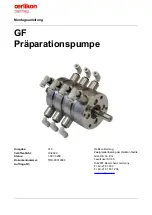
Refrigeration Maintenance and Service Operations
129
9. Pressurize the system with nitrogen to 1380
kPa, 13.80 bar, 200 psig.
10. Close the supply valve on the nitrogen bottle.
11. Use an electronic leak tester to inspect all
joints and connections. (Use a soap solution as
an alternative test component.)
NOTE: If system leakage is indicated, loosen
supply line hose fittings to release pressure.
Repair leakage condition.
12. If system repair is necessary, recheck system
after repairs are completed.
Low Side Pump Down
1. Install the gauge manifold on the compressor.
2. Set the controller setpoint temperature well
below the return air temperature and operate
the unit in the Cool mode until the
temperature stabilizes (at least 5 minutes).
3. Close the liquid line service valve. Allow the
unit to operate until it reaches -15 to -40 kPa,
-0.15 to -0.40 bar, 5 to 11 in. vacuum on the
suction pressure gauge (3-5 minutes). Then
shut the unit down manually with the On/Off
switch.
4. To place the unit back in service, open the
liquid line service valve and turn the On/Off
switch ON.
Refrigerant Charge
The refrigerant charge should be checked during
pretrip and routine maintenance inspections. A
low charge of refrigerant will cause the container
temperature to rise due to the lack of liquid
refrigerant at the expansion valve even though the
unit is operating in a cooling mode. The
refrigerant charge can be checked by inspecting
the receiver tank sight glasses.
NOTE: See “Receiver Tank Sight Glass” under
Unit Instruments in the Operating Instructions
chapter for information about checking the
moisture indicator in the sight glass.
Unit Refrigerant Charge:
•
Standard receiver: 4.9 kg (10.8 lb) of R-134a.
•
Water-cooled condenser-receiver: 5.2 kg
(11.5 lb) of R-134a.
Checking the Refrigerant Charge
1. Inspect the receiver tank sight glasses with the
unit operating in COOL.
2. a. Standard Receiver Tank:
•
If the balls FLOAT in the sight glass at any
time, R-134a charge is OK.
•
If the balls DO NOT FLOAT, R-134a
charge is low.
b. Water-cooled Condenser-receiver Tank with
two sight glass:
•
If the BOTTOM sight glass balls FLOAT,
the R-134a charge level is ok.
•
If the BOTTOM sight glass balls DO NOT
FLOAT, R-134a charge level may be low.
Go to step 3.
c. Water-cooled Condenser-receiver Tank with
one sight glass:
•
If the balls FLOAT in the sight glass at
any time, R-134a charge is ok.
•
If the balls DO NOT FLOAT, R-134a
charge may be low
CAUTION: Nitrogen (N
2
) is under 15,170
kPa, 151.70 bar, 2200 psig pressure in a
full cylinder at 21 C (70 F). DO NOT use
oxygen, acetylene or any other type of
pressurized gas in the system.
CAUTION: Never open the low side to the
atmosphere while it is in a vacuum. Air
and moisture will be drawn in and
contaminate the refrigerant system.
Содержание CRR-40 119
Страница 4: ......
Страница 16: ...Safety Precautions 16...
Страница 18: ...Service Guide 18...
Страница 20: ...Model Features 20...
Страница 32: ...Specifications 32...
Страница 120: ...MP 3000a Controller 120...
Страница 160: ...Wiring and Schematic Diagrams Index 160...
Страница 161: ...161 MPC2000 Wiring Schematic...
Страница 162: ...162 MPC2000 High Voltage Wiring Diagram...
Страница 163: ...163 MPC2000 Low Voltage Wiring Diagram...
Страница 164: ...164 MPC2000 WCC Wiring Schematic...
















































